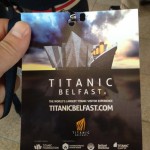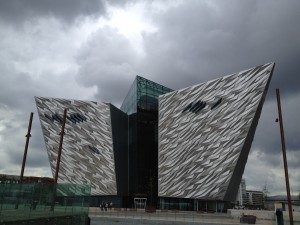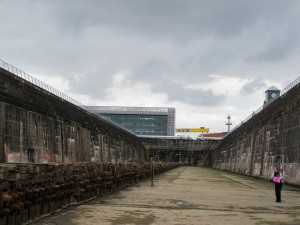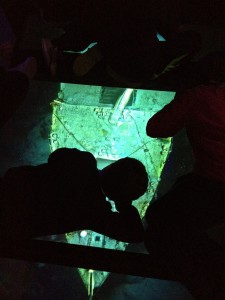Titanic Quarter–Belfast, Northern Ireland
 The first thing I am told, before I ventured into the confines of Titanic Belfast, the city’s newest exhibition, is that it’s not a museum. Titanic Belfast opened its doors to coincide with the 100th anniversary, in April, of the ship’s 1912 sailing. My guide, Victoria, reiterates again. “Please please please please please please do not call it a museum.” She says this with so much pleading and such passion you would think she was asking me not to sell her dog into slavery.
The first thing I am told, before I ventured into the confines of Titanic Belfast, the city’s newest exhibition, is that it’s not a museum. Titanic Belfast opened its doors to coincide with the 100th anniversary, in April, of the ship’s 1912 sailing. My guide, Victoria, reiterates again. “Please please please please please please do not call it a museum.” She says this with so much pleading and such passion you would think she was asking me not to sell her dog into slavery.
The gist, she tells me, is that it is an experience. Whatever it is, I’m pretty sure it’s definitely not a museum.
Looking at the building, which is a remarkable piece of architecture built to resemble—depending on who you talk to—either the bow of four ships…or its nemesis the iceberg, I couldn’t help but wonder whether it should exist at all. It is, after all, not an inspiring tale.
At the time of it’s commissioning, along with its two sister ships, it was the largest man made transport in the world. Right up until it sank it was a marvel of engineering and the pride of Belfast.
I expected the experience to be a bit of a downer. But eventually I found myself being impressed anyway. What impresses is not the story—which everyone has heard, most recently in 3D—but the scale of the endeavor, and, well, all the numbers.
It’s a fetish of sorts. The Thompson Dock, where the Titanic sat at port, would hold “160 million pints of Guinness.” The ship was put together with “3 million rivets.”
Walking into the bottom of the ship’s one-time berth, which has been pumped free of water, is to stare up from 44 feet below sea level and think: @&*&*!
The size and scale of everything just starts piling up: the ships two anchors weighed 31 tons; each engine weighed 720 tons; 29 boilers, each weighing 91.5 tons had 157 furnaces which were to burn the 7,703 tons of coal the ship carried.
To continue on with the numbers would take weeks and addle the brain; but here’s a few more anyway: there were 2,223 passengers—and 40,000 eggs and 2,500 pounds of sausage and 80,000 pounds of potatoes—for a five day cruise. After a while all of these numbers had me hooked.
After getting a tour of the dock, it was time for the Experience, or whatever it is. I walked into the non-museum and I saw the gift shop and I briefly thought: seriously? What’s to brag about? Who wants a Titanic! baseball cap or a Titanic giant pencil eraser? And then I looked up at the size of the place, and thought about the money invested ($150 million) and I figured I might as well have a look around.
Then I heard about the ride. “Is the ride up and running?” someone asked. I thought, there’s a ride? Hey! This really isn’t a museum!
“So far so good…” someone replied casually. That gave me pause, until I thought about what a good story it would be to get stuck on a ride about a ship that crashed.
You embark into the Titanic experience as if you are embarking on the ship itself, and you turn a corner, as if turning a corner on the gangway to the ship, and there an elevator awaits. It’s a re-creation of the lift that would have taken the ship builders to the top of the ship to hammer on things. Only this one has windows and safety measures employed, and it’s only a third of the height.
At the top a guide is waiting. And from her I learned this: there were no safety ropes for the workers back then; and the only people who wore hard hats on the job site were the poor saps whose job it was to monitor how long you took to pee. If you went over your allotted time you would be docked; thus workers took to hurling molten rivets down at the bathroom timer; thus they got to wear hard hats.
If you are picturing the kind of ride where you get in one of those cars with the bar that comes down and where you are told to “keep hands and arms inside the car at all times” and then it carries you off into space, you will not be disappointed. It carried me through a very expensive re-creation of the working conditions of the shipbuilders: lots of hot metal, lots of tiny spaces, lots of lost thumbs and fingers. I was once again bombarded with scale and numbers; and I started to understand why Belfast is so proud of what seems like something best forgotten.
After the ride, I walked down into a re-creation of the ships bridge, where I saw the S.O.S. messages about the ship hitting an iceberg. And I saw the other ships replies, telling the Captain that they are really far away, but they are on their way. Hmm. I had forgotten about it crashing! Then I walked through an homage to those that went down and those that survived and I heard their stories and learned their backgrounds and James Cameron seemed a long way away. (But, as you probably know, James Cameron is never far away.) It may have its own theme park ride, but the experience doesn’t shy away from the tragedy.
Finally, for the kids, I got to the bottom floor, which focuses on the deep sea exploration of the doomed vessel. Kids can lie on the floor and look down on the ship as if they were right there in the submersible 12 miles below, in the murky depths of the Atlantic, as a voiceover talks about what is being seen. (confession: it’s pretty cool.)
Then, like in most non-museums, I got shot out into the gift shop. But I didn’t buy anything; because, it’s still a tragedy and buying an overpriced reminder of it just seems silly.
What also seems silly is spending so much money on an exhibition that will never get as much attention as it will this year. But Belfast, after crawling out of the rubble of decades of religious conflict, doesn’t have a lot to brag about. So they’ve gone all in with the Titanic. Because, as they see it, the ship was fine; it was the damned iceberg that screwed everything up.
For more information, go here.




